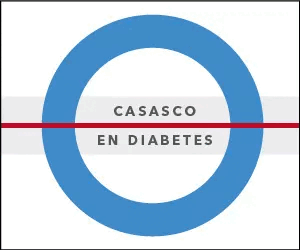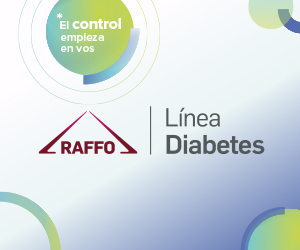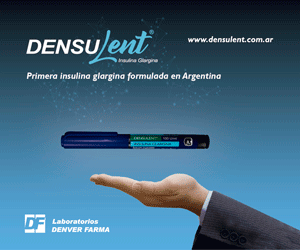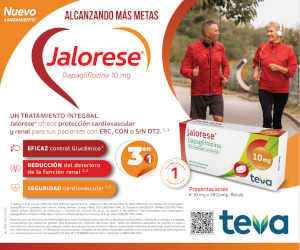¿Es útil A1C para diagnóstico y seguimiento de diabetes mellitus tipo 2?
DOI:
https://doi.org/10.47196/diab.v47i3.212Keywords:
type 2 diabetes mellitus, hemoglobin a1c (a1c), diagnosis, follow-upAbstract
Objectives: to assess the significance physicians give to glycosylated hemoglobin A1c (A1C) for diagnosis and follow-up in type 2 Diabetes patients and their values for diagnosis and therapeutical targets according to speciality. Material and Methods: observational, crosssectional study performed through surveys to physicians attending the Argentine Congress on Diabetes (2010). Specialties were: Nutrition, Diabetology, Endocrinology, Internal Medicine, General Medicine and other. Statistical analysis: descriptive statistics, Chi2 test, ANOVA (Student-Newman-Keuls post hoc). Software: Med-Calc 2009.Results: 743 surveys, mean age 43,3+10,4 years. 69,3% female. 32.9% of the surveyed physicians considered A1C non-beneficial for diagnostic purposes. The mean for diagnosis was 6,56 + 0,42% and 25% of the surveyed physicians considered A1C >7 as value for diagnosis. Physicians request A1C to 95,5% of patients, with differences between groups P<0,001. The frequency range for requesting A1C was every 3 months. 4,2% did not perform A1C dosages due to lack of access. The objective of the A1C for treatment was 6,7 ± 0,43%, with no differences per group p = 0,79. 72,5% showed having more flexibility in target value in elder people, CVD and risk of hypoglycemia. 87,9% considered the A1C useful to assess cardiovascular risk. Conclusions: 33% considered the A1C not appropriate for diagnosis. For those considering it useful, the cut-off value was approximately 6,5%. The target value for follow-up was close to 6,5% and flexible for elder people, CVD and risk of hypoglycemia. The test was considered beneficial for assessing cardiovascular risk.References
Stratton IM, Adler AI, Neil HA, et al. Association of glycemia with macrovascular and microvascular complications of type 2 diabetes (UKPDS 35): prospective observational Study. BMJ 2000; 321 (7258):405-412.
Sacks DB. Measurement of Hemoglobin A1c. A new twist on the path to harmony. Diabetes Care 2012; 35:2674-2680.
The international expert committee. International expert committee report on the role of the A1c assay in the diagnosis of diabetes. Diabetes Care 2009; 32:1327-34.
Position statement. Diagnosis and classification of diabetes mellitus. American Diabetes Assosiation. Diabetes Care 2013; 36 (supll 1):S67-74.
Position statement. Standards of Medical Care in Diabetes-2013. American Diabetes Assosiation. Diabetes Care 2013; 36 (supll 1):S11-S66.
Sacks DB, Arnold M Makris GL, et al. Position statement. Executive summary: guidelines and recommendations for laboraty analysis in the diagnostic and managament of Diabetes Mellitus. Diabetes Care 2011; 34:1419-1423.
Ismail-Beigi F, Moghissi E, Tiktin T, et al. Individualizing glycemic targets in type 2 diabetes mellitus: implications on recent clinicals trials. Ann Intern Med 2011; 154:554-559.
Inzucchi SD, Bergenstal RM, Buse JB, et al. Managament of hyperglycemia in type 2 diabetes: A patient- centered approach. Position statement of the Americam Diabetes Association and the European Association for the study of diabetes. Diabetes Care 2012; 35:1364-1379.
Cefalu WT. American Diabetes Association- European Association for the study of Diabetes Position Statement: due diligence was conducted. Diabetes Care 2012; 35:1201-1203.
Holman RR, Paul SK, Bethel Ma, Matthews DR, Neil HAW: 10 year follow-up of intensive glucose control type 2 diabetes. N Engl J Med 2008; 359:1577-1589.
Consensus Statement on the World-wide standardization of the hemoglobin A1c measurament: the Americam Diabetes Association, European Association for study of Diabetes, International Federation of clinical, Chemistry and laboratory medicine, and the international diabetes Federation. Diabetes Care 2007; 30:2399-2400.
2010 Consensus Statement on the Worldwide standardization of the hemoglobin A1C measurement. ADA, EASD, IDF, IFCC and ISPAD. Diabetes Care 2010; 33:1903-1904.
2013 Update on the worldwide standardization of the haemoglobin A1c measurement. Diabetes Research and clinical practice 2013; 100:e64-65.
Colagiuri S, Borch-Johsen K. DETECT-2 early detection of type 2 diabetes and IGT. Diabetes Voice 2003; 48:11-13.
Traverso R, Frechtel G, y col. Convergencias, divergencias, variabilidad, puntos de corte e indicación de la glucemia de ayuno, la hemoglobina glicosilada e insulinemia. Rev SAD 2010, Vol. 44, Nº 3: 208-224.
Gerstein HC, Miller ME, Byington RP, et al. Action to Control Cardiovascular Risk in Diabetes Study Group. Effects of intensive glucose lowering in type 2 diabetes. N Engl J Med 2008; 358:2545-2559.
Turnbull FM, Abraira C, Anderson RJ, Byington RP, et al. Intensive glucose control and macrovascular outcomes in type 2 diabetes. Diabetologia 2009; 52:2288-2298.
Patel A, MacMahon S, Chalmers J, et al. ADVANCE Collaborative Group. Intensive blood glucose control and vascular outcomes in patients with type 2 diabetes. N Engl J Med 2008; 358:2560-2572.
Skyler JS, Bergenstal R, Bonow RO, et al American Diabetes Association; American College of Cardiology Foundation; American Heart Association. Intensive glycemic control and the prevention of cardiovascular events: implications of the ACCORD, ADVANCE, and VADT diabetes trials: a position statement of the American Diabetes Association and a scientific statement of the American College of Cardiology Foundation and the American Heart Association. Diabetes Care 2009; 32:187-192.
Selvin E, Marinopoulos S, BerKenblit G, et al. Meta-analysis: glycosylated hemoglibin and cardiovascular disease in diabetes mellitus. Ann Intern Med 2004; 141:421-431.
Stettler C, Allermann S, Juñi P, et al. Glycemic control and macrovascular disease in type 1 and 2 diabetes mellitus: Meta-analysis of ramdomizar trials. Ann Heart J 2006; 152:27-38.
Kirkman MS, Briscoe VJ, Clark N, Florez H, Haas LB, Halter JB, et al. Consensus report. Diabetes in Older adults. Diabetes Care 2012; 35:2650-2664.
Riddle MC, Karl DM. Individualizing targets and tactics for high- risk patients with Type 2 Diabetes. Practical lessons from ACCORD and other cardiovascular trials. Diabetes Care 2012; 35:2100-07.
Greenfield S, Billimek J, Pellegrini F, Franciosi M, De Berardis G,Nicolucci A, et al. Comorbidity affects the relationship between glycemic control and cardiovascular outcomes in Diabetes. Ann Intern Med. 2009; 151:854-860.
Selvin E, Sreffes M, Zhu H, Matsushita K, Wagenknecht L, Pankow J et al. Glycated hemoglobin, Diabetes, and Cardiovascular Risk in non diabetic adults (ARIC Study). N Engl J Med 2010; 362:800-11.
Downloads
Published
How to Cite
Issue
Section
License

This work is licensed under a Creative Commons Attribution-NonCommercial-NoDerivatives 4.0 International License.
Dirección Nacional de Derecho de Autor, Exp. N° 5.333.129. Instituto Nacional de la Propiedad Industrial, Marca «Revista de la Sociedad Argentina de Diabetes - Asociación Civil» N° de concesión 2.605.405 y N° de disposición 1.404/13.
La Revista de la SAD está licenciada bajo Licencia Creative Commons Atribución – No Comercial – Sin Obra Derivada 4.0 Internacional.
Por otra parte, la Revista SAD permite que los autores mantengan los derechos de autor sin restricciones.

































